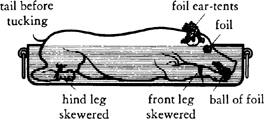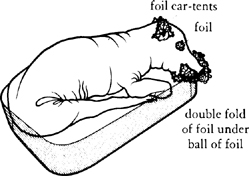Mastering the Art of French Cooking, Volume 2 (101 page)
Read Mastering the Art of French Cooking, Volume 2 Online
Authors: Julia Child

3 to 4 ounces (½ cup) seedless black raisins or currants
A bowl of very hot water
Drop raisins into hot water and let soften 10 to 15 minutes. Drain, squeeze dry in the corner of a towel, and add to mixing bowl.
½ lb. (1⅓ to 1½ cups) best-quality dried apricots
A bowl of very hot water
1 cup beef stock or bouillon
A heavy covered saucepan
Big pinch allspice
Soak apricots for 10 to 15 minutes until somewhat softened. Drain, and simmer slowly in bouillon with
allspice until just tender enough to eat (not mushy). Drain, reserving any liquid for your final sauce. Cut apricots into ¾-inch pieces and add to mixing bowl.
A rubber spatula
¼ tsp each: ground fennel seeds, thyme, and oregano
⅛ tsp ground imported bay leaf
⅛ tsp white pepper
Salt
Gradually blend the cooked rice into the mixing bowl, turning gently with the rest of the ingredients and the herbs and seasonings listed here. Taste very critically for seasoning, adding more salt, pepper, and herbs if you think them necessary.
(*)
AHEAD-OF-TIME NOTE
: Stuffing may be made a day in advance; cover and refrigerate.
3)
Stuffing the pig
2 tsp salt
⅛ tsp white pepper
6 to 8 skewers or finishing nails about 3 inches long
White string
Aluminum foil
Turn the pig on its back, and season cavity with salt and pepper. Spread in the stuffing, filling the cavity completely but not forcing it. (Reserve any extra stuffing; cook separately, in a covered dish.) Close cavity with skewers and lace them in place with string. If there is a slit under the chin, season with salt and pepper, but it need not be closed. Crumple foil into a ball 2 to 2½ inches in diameter, force pig’s jaws open, and insert ball to keep them open.
4)
Into the roasting pan
½ cup or more olive oil or cooking oil in a small pan
A basting brush
A shallow roasting pan at least 20 inches long with rack
More skewers and string if needed
Aluminum foil
Optional but recommended: a meat thermometer
Dry surface of pig again with paper towels, and paint pig all over with oil.
| If pig will fit in a straight crouch in pan, skewer and tie hindlegs and forelegs in place to brace pig in position; let head rest between forelegs. |
Or arrange pig in a less formal position, hind legs extended forward, and forelegs curled under. |
|
If chin sticks out over lip of pan in either position, put a double thickness of foil under it so that roasting juices will drain back into pan. Insert balls of foil into the eye sockets; make tents of foil to cover the ears and protect them during roasting. To protect tail, tuck into rear opening. Insert meat thermometer into thickest portion of thigh, being sure its point is not touching any bone.
(*)
AHEAD-OF-TIME NOTE
: Although pig may be stuffed the day before roasting if both stuffing and pig have been chilled separately beforehand, you will have to leave the pig out at room temperature for 2 to 3 hours before roasting or timing will be difficult and roasting may be uneven.
5)
Roasting—oven preheated to 450 degrees; 3 to 3½ hours (2½ to 3 hours roasting plus a 30-minute rest)
The oil and the basting brush
1 cup roughly sliced onions
⅔ cup roughly sliced carrots
4 cloves of garlic, whole and unpeeled
Set pan with pig in lower-middle level of preheated 450-degree oven. In 15 minutes, rapidly brush entire surface of pig with oil. Roast 15 minutes more, baste again with oil, and turn thermostat down to 350 degrees.




